
Conospermum glumaceum, commonly known as hooded smokebush, is a species of flowering plant in the family Proteaceae and is endemic to the south-west of Western Australia. It is an erect shrub with more or less clustered, linear leaves, and panicles of dense, head-like spikes of tube-shaped, cream-coloured flowers and white to golden nuts.

Calytrix depressa is a species of flowering plant in the myrtle family Myrtaceae and is endemic to the south-west of Western Australia. It is a glabrous shrub with linear to lance-shaped leaves and mauve to violet or yellow flowers with 35 to 75 stamens in several rows.

Calytrix aurea is a species of flowering plant in the myrtle family Myrtaceae and is endemic to the south-west of Western Australia. It is a shrub with elliptic, lance-shaped or linear leaves and clusters of yellow flowers with 25 to 55 yellow stamens in several rows.
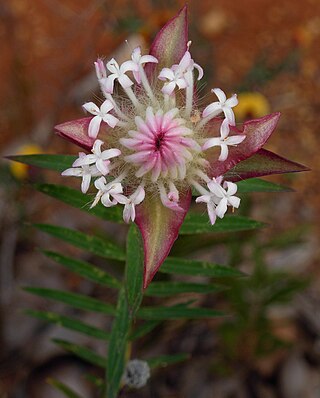
Pimelea spectabilis, or bunjong, is a species of flowering plant in the family Thymelaeaceae and is endemic to the south-west of Western Australia. It is an erect shrub with very narrowly elliptic leaves and heads of white, pale pink or pale yellow flowers surrounded by 4 or 6 egg-shaped involucral bracts.
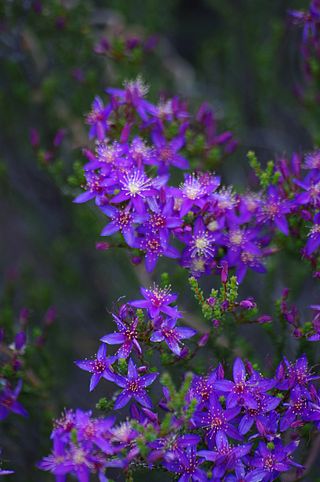
Calytrix leschenaultii is a species of flowering plant in the myrtle family Myrtaceae and is endemic to the Southwest Australia of Western Australia. It is a mostly glabrous shrub with egg-shaped, elliptic, lance-shaped or linear leaves and purple, mauve, violet or pink flowers with a white or yellow base, and 6 to 40 white or yellowish stamens.
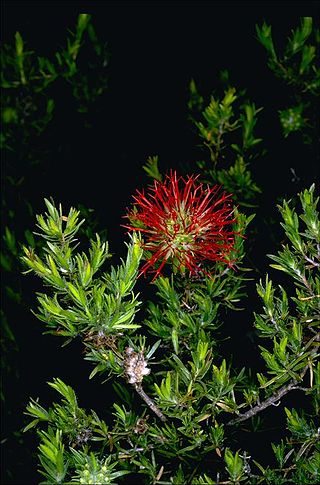
Beaufortia macrostemon, commonly known as Darling Range beaufortia, is a species of plant in the myrtle family, Myrtaceae and is endemic to the southwest of Western Australia. It grows as a low shrub with multiple stems, hairy young leaves and three stamens in each stamen bundle.

Beaufortia purpurea, commonly known as purple beaufortia, is a species of flowering plant in the myrtle family, Myrtaceae and is endemic to the southwest of Western Australia. It is an erect or spreading shrub with linear to egg-shaped leaves and purplish-red flowers in dense heads on the ends of branches which continue to grow after flowering.

Darwinia pinifolia is a species of flowering plant in the family Myrtaceae and is endemic to the southwest of Western Australia. It is a low, spreading to prostrate shrub with linear leaves and dense heads of erect, red to purple flowers.

Calytrix acutifolia is a species of flowering plant in the myrtle family Myrtaceae and is endemic to south-west of Western Australia. It is a slender, openly-branched shrub with linear to lance-shaped leaves and clusters of white, cream-coloured or yellow flowers with 40 to 85 white stamens in several rows.

Calytrix asperula, commonly known as brush starflower, is a species of flowering plant in the myrtle family Myrtaceae and is endemic to the south of Western Australia. It is a mostly glabrous shrub with linear to narrowly elliptic leaves and cream-coloured to yellow flowers with 40 to 60 yellow stamens in several rows.
Calytrix breviseta is a species of flowering plant in the myrtle family Myrtaceae and is endemic to the south-west of Western Australia. It is a more or less glabrous shrub with egg-shaped, elliptic, lanceolate, oblong or linear leaves and clusters of purple flowers with about 25 to 65 white stamens in several rows, becoming reddish-purple as they age.
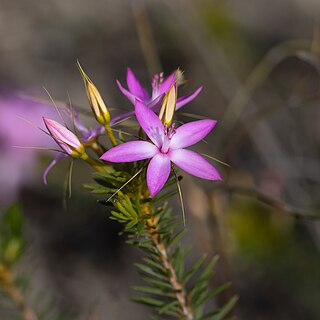
Calytrix decandra, commonly known as pink starflower, is a species of flowering plant in the myrtle family Myrtaceae and is endemic to the south of Western Australia. It is a semi-prostrate, glabrous shrub with linear to narrowly elliptic leaves and pink, mauve or magenta flowers with usually 10 stamens in a single row.

Calytrix flavescens, commonly known as summer starflower, is a species of flowering plant in the myrtle family Myrtaceae and is endemic to the south-west of Western Australia. It is a shrub with linear to narrowly elliptic leaves, and yellow flowers with about 35 to 60 stamens in several rows.

Calytrix fraseri, commonly known as pink summer calytrix or pink summer starflower, is a species of flowering plant in the myrtle family Myrtaceae and is endemic to the south-west of Western Australia. It is a shrub with oblong, linear or elliptic leaves with the narrower end towards the base, and pink, cerise or pinkish purple flowers with about 35 to 55 stamens in several rows.

Calytrix glutinosa is a species of flowering plant in the myrtle family Myrtaceae and is endemic to the south-west of Western Australia. It is a more or less glabrous shrub with linear leaves and clusters of pink to mauve flowers with about 10 to 20 white stamens in one or two rows, becoming reddish-purple as they age.
Calytrix gracilis is a species of flowering plant in the myrtle family Myrtaceae and is endemic to the south-west of Western Australia. It is a glabrous shrub with linear leaves and scattered violet to deep blue flowers, with about 65 to 125 white to yellow stamens in several rows, becoming reddish as they age.
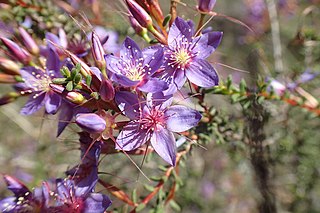
Calytrix violacea is a species of flowering plant in the myrtle family, Myrtaceae and is endemic to the southwest of Western Australia. It is a shrub with linear to narrowly egg-shaped leaves with the narrower end towards the base, and purple, star-shaped flowers.
Calytrix harvestiana is a species of flowering plant in the myrtle family Myrtaceae and is endemic to the west of Western Australia. It is a glabrous shrub with linear, elliptic or egg-shaped leaves and purplish mauve to purple or violet flowers with about 60 to 70 pale yellow stamens in multiple rows.
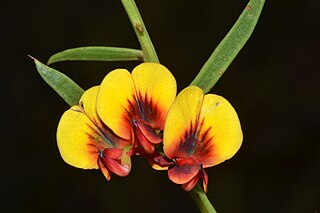
Daviesia angulata is a species of flowering plant in the family Fabaceae and is endemic to the south-west of Western Australia. It is an erect, spreading shrub with prickly, flattened phyllodes, and yellow flowers with red markings.

Calytrix alpestris, commonly known as snow-myrtle, is a species of flowering plant in the myrtle family Myrtaceae and is endemic to southern continental Australia. It is a shrub with wiry branchlets, linear to narrowly egg-shaped or narrowly lance-shaped leaves and clusters of white flowers with 14 to 37 white stamens in a single row.

















